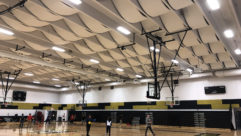LADDERS for the systems contractor
May 1, 2000 12:00 PM,
Glen Ballou
Most of us in the audio business spend much more of our time looking upthan down. Because our ears are on our head rather than our feet, our toolsare not shovels; they are ladders, hoists, genies and the like. Hangingloudspeakers requires many special tools, but none of them will do us theleast bit of good if we cannot reach the loudspeaker position. Of course,we can stand on a folding chair, but our chances of surviving this withoutinjury for any period of time are pretty slim. For average, low-ceilinginstallations, step ladders are probably quite satisfactory. High ceilings,on the other hand, require extension ladders or work stands.
There are many types of ladders – type IA, 1, H, III, commercial andhousehold ladders, wood ladders, aluminum ladders and fiberglass ladders.The question is what kind to use for which project. If, for example, I amworking near electricity with a chance that the ladder can hit open wire, Iwill try not to use metal. I would much rather carry the extra weight thanhave my fingers freeze to the metal in cold weather. If, however, we arelooking for a ladder that will last, not rot, not twist and becomeunstable, and not conduct electricity, fiberglass is the ideal ladder ofchoice.
Installing 8 inch (203 mm) ceiling loudspeakers in low ceilings is not toodifficult, so usually a 6 foot to 10 foot (1.8 m to 3 m) step ladder willsuffice. It just means going up and down repeatedly. Of course, we willneed a tool pouch so that we can carry our tools with us. There are fewthings worse than leaving a tool somewhere in the ceiling and having tofind it one loudspeaker location at a time.
Suppose we need to hang a loudspeaker in a high-ceiling church. If we arebrave, we can set up an extension ladder against a beam and climb towardheaven. We might want to use a safety harness just in case. This is where achainfall comes in handy. We can never carry a loudspeaker up an extensionladder and hang it, let alone loudspeaker clusters. We can, however, use aladder to hang the chainfall from a beam and raise the loudspeaker from thefloor, then use our ladder to stand on to mount the loudspeaker to thebeam. If we do a lot of cluster hanging, a hydraulic or mechanical liftcomes in handy. Do not forget that they are not made to move people.
What should we look for when purchasing a ladder? First, it shoulddefinitely meet OSHA and ANSI standards, and if in Canada, it should meetCSA grade I Canada standards. Next, we should decide how we are going touse the ladder. Is it for small, infrequently performed jobs, or do we useladders every day? Ladders come in four basic categories – type IA, 1, Hand III. Type IA has a carrying capacity of 300 pounds (135 kg) and is usedfor extra heavy-duty industrial jobs. We can also purchase IA ladders thatare dual access; they have steps on both sides so that we can climb upeither side or have a helper on the opposite side. Type I has a 250 pound(112.5 kg) capacity and is good for heavy-duty industrial use. Type H has a225 pound (101.3 kg) capacity and is used for medium-duty commercial work,while type III has a 200 pound (90 kg) capacity and is used for light-dutyhousehold jobs. Remember, the load carrying capacity includes the combinedweight of the user, tools and an!y material on the ladder.
The next thing we need to determine is the size of ladder needed. If we areusing a step ladder, the maximum standing height is 2 feet (610 mm) lessthan the ladder size. On extension ladders, the maximum extended ladderlength (the extended length of the ladder with extension overlap of the twosections) varies from 13 feet (4 m) for a 16 foot (4.9 m) ladder to 35 feet(10.7 m) for a 40 foot (12.2 m) ladder. The maximum working height is 7feet (2.1 m) less for a 16 foot ladder and 9 feet (2.7 m) less for a 40foot ladder.
Next, we should determine the material of which we want the ladder to bemade. The three major materials are aluminum, wood and fiberglass. Aluminumladders are strong and lightweight. Unfortunately, our hands might freezeonto them in cold weather. They conduct electricity quite well and have, attimes, been known to blow circuit breakers and electrocute people. Forthese reasons, I prefer wood or fiberglass. Wood ladders are strong andrelatively inexpensive, but they absorb water and paint, and after heavyusage, they often become rickety. Fiberglass does not absorb water likewood and has a high dielectic strength of 25,000 V per inch. It does notrot, corrode or warp. One thing we do have to be careful of is that therungs are usually aluminum, and they can conduct electricity. Most aluminumand fiberglass ladders can be purchased with either round or D rungs, whichare much more comfortable to stand on.
A specialized multipurpose ladder that we might want to consider can bemanipulated into various configurations (see Figure 1). This ladder isprobably a best all-around buy.
Another specialized ladder is the platform ladder, which has a rather large(150 infinity 200 or 381 mm infinity 508 mm) platform on which to stand andmaneuver. The back legs are nearly vertical, allowing the user to push ittightly against a surface. A worthwhile accessory for these ladders is aspring-loaded caster set. The ladder rolls easily on the floor whenunloaded and does not move when the user’s weight compresses the springs,placing the rails of the ladder firmly on the ground.
Along with the ladder, there are various accessories to consider. Forinstance, we might want a pail shelf, a surface protection kit or anadjustable stand-off kit. We may also want ladder levelers so that we canhave one side rail on one step of a stairwell and the other side rail on adifferent step. Another useful accessory is ladderjacks, which allow theuser to hang a stage between two ladders. Of course, this brings us topurchasing an aluminum stage or just a couple of 20 infinity 80 (51 mminfinity 203 mm) planks so that we can walk back and forth between the twoladders. Aluminum stages often have a two-man load capability of 500 pounds(225 kg), and they conduct electricity. I recommend using rail and toeboardkits if you are going more than 10 feet (3 m) above the floor.
There are certain times when a ladder simply will not suffice. It is atthis point when the maintenance platform or mobile work standard comes intoplay. The standard platform is about 6 feet (1.8 m) high and can beadjusted from 2.5 feet (762 mm) to 6 feet with quick-locking pins. Theplatforms can be extended to various heights by adding sections. Theseunits usually come with locking wheels and a guard rail and toeboard. Loadcarrying capacity is given in pounds per square foot and often ranges from50 pounds (22.5 kg) for the 6 foot unit to 25 pounds (11.3 kg) for 12 feet(3.7 m) and above.
Mobile work stands, although they will generally perform the same basic jobas platforms, are adjustable only from 12 inches to 48 inches (305 mm to1.2 m), have a 500 pound (225 kg) limit and fold quickly for transporting.Of course, there are number of other means of getting around ceilings, butthese are the most common and the most useful.










